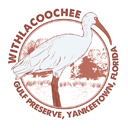
The Florida black bear, Ursus americanus floridanus, can be found throughout Florida, including Yankeetown! This subspecies of the American black bear was listed as threatened in the 1970’s, with a population in the low hundreds. Today biologists estimate the black bear population in Florida to be above 4,000. This is a tenfold increase from the historic low.
With this success comes an increase in people and bear encounters. In the Big Bend region sightings are not uncommon. If you see a bear from a distance, feel fortunate and enjoy the experience. If you encounter a bear at close range, avoid eye contact and back away slowly, while speaking to the bear in a calm assertive voice. Hold your ground if a bear huffs or snorts, paws the ground, or charges toward you. If you do the bear will likely stop and move away.
Florida bears generally have black fur with a tan muzzle. Adult bears range in weight from 150 to 400 pounds (68 to 181 kg), with males often twice the size of females.
The bear breeding season in Florida runs from June to August. Bear cubs weight about 12 oz. (350 g) at birth, with litter size between 1 and 5. The gestation period lasts 235 days, and litters are usually born in late January to early February.
Bears are omnivores and range over a large area to forage: 15 square miles for female and 62 square miles for males. Their diet is derived 80% from plants (fruits, berries, nuts), 15% from insects, and 5% from meat such as opossums, armadillos, and carrion.
The Friend’s would like to thank Vic Doig, Wildlife Biologist & Fire Management Officer at the US Fish & Wildlife Service, and Brian Scheick, Bear Research Program Coordinator at the Florida Fish and Wildlife Conservation Commission (FWC) for several great presentations at the WGP Education Center. For more information about Florida black bears visit FWC at: myfwc.com/research/wildlife/terrestrial-mammals/bear/.






 The Rescue Program responds to sick, injured, and deceased marine mammals in Levy, Dixie, and Taylor counties of the Big Bend. They coordinate rescues of live animals and, if possible, transport them to rehabilitation facilities. They also perform necropsies (animal autopsies) on deceased marine animals to determine their cause of death and learn more about their anatomy, physiology, and the health of their ecosystem.
The Rescue Program responds to sick, injured, and deceased marine mammals in Levy, Dixie, and Taylor counties of the Big Bend. They coordinate rescues of live animals and, if possible, transport them to rehabilitation facilities. They also perform necropsies (animal autopsies) on deceased marine animals to determine their cause of death and learn more about their anatomy, physiology, and the health of their ecosystem. Gopher tortoises (Gopherus polyphemus) are long-lived reptiles native to the southeastern United States. They occupy upland habitat throughout Florida including forests and pastures. Gopher tortoises are herbivore scavengers and consume a variety of plants, including grasses and terrestrial legumes. (Photo by FWC Research)
Gopher tortoises (Gopherus polyphemus) are long-lived reptiles native to the southeastern United States. They occupy upland habitat throughout Florida including forests and pastures. Gopher tortoises are herbivore scavengers and consume a variety of plants, including grasses and terrestrial legumes. (Photo by FWC Research)